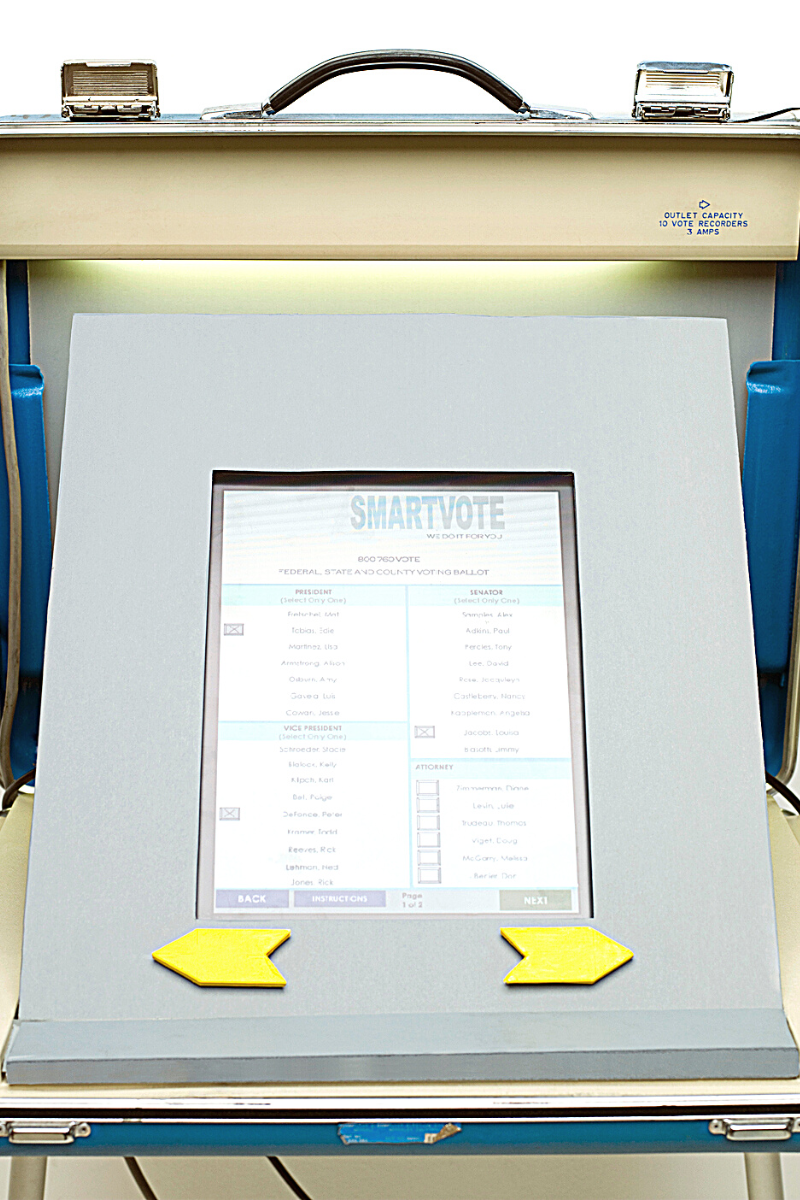How many people gleefully slap an “I Voted” sticker across their breast pocket, with little thought as to what happens to that vote the moment you step away from the 90s-style ATM-like contraption? On the other end of the spectrum, some are deeply distrustful of the U.S.’s voter technology, spurred by lingering concerns following the 2020 Presidential Election. And let’s not forget that two decades before that, the Gore versus Bush election also drummed up widespread quarreling over punch-card voting machines in Florida, reportedly riddled with design flaws.
So, where exactly does America stand when it comes to the wizardry behind the American electoral system? There is no one size fits all.
The election system, for better or worse, is highly decentralized. Each state, county, and jurisdiction establish its own rules, regulations, and procedures; thus, there is no singular governing body to manage the critical component of our democracy. From a human labor point of view, elections rely heavily upon public service poll workers to facilitate the process, set up polling sites, test machines, check in voters, and keep the long day running as smooth as possible. (And yes, gift you with a sticker at the end.)
Historically, the U.S. has moved through various technological methods when it comes to election day. Hand-counted ballots typically marked with an X still have a place in our current system, although rarely used. The first mechanical lever machines were used in the 1890s and functioned by the voter lowering the lever next to their chosen candidate behind a closed curtain to ensure privacy. These can no longer be used in federal elections; however, some states and small precincts use the machines for local voting procedures.

In the 1960s, punch-card voting devices became the norm. A blank pre-scored card is inserted into the holder, and a voter creates a hole next to their preferred candidate’s number before dropping the card into the ballot box. The federal government no longer allows these to be used, but again, they can be used locally.
It was also during the 1960s that scanned paper ballots were developed. During that time, computers scanned the hand-marked ballots placed in a deposit box. The following decade introduced us to Direct-Electronic (DRE) machines, basically electronic versions of the old-fangled mechanical lever machines with push buttons instead of mechanical levers. More advanced DRE technologies – from portable computers to touch screens – remain at the heart of our electoral processes today.
But despite the innovations surrounding us, the last two decades have been fraught with concerns over voting, audit, and system flaws – from both sides of the political spectrum. Despite the mammoth technological advances, adopting and deploying improved strategies remain subject to political posturing and funding availability. And like any imperfect operation, the electoral process is vulnerable to intentional and unintentional blunders.
According to EconoFact, a non-partisan publication published by the Edward R. Murrow Center for a Digital World at The Fletcher School at Tufts University, the “back end” functions are just as critical as the actual computers and software now used.
“Components include maintaining a database of registered voters; creating the data files for each ballot before the election; configuring individual precinct voting machines; processing absentee and early voting ballots; and tabulating the results for each race and reporting the overall outcomes,” the report notes. “The risk presented by the voting equipment depends on the type of equipment used, which varies from location to location. For example, some locations use optical scanners that read paper ballots and leave a paper record of the vote; others use purely electronic voting, and others allow voters to vote electronically and then print a paper version of the ballot to be read by an optical scanner.”
As mentioned, the election technology used is highly disintegrated. There are no specific standards for security and auditing, with all decisions made at state or local levels. The U.S. Election Assistance Commission (EAC) provides guidance, but it is the state’s discretion on how to operate and the technology purchased.
As Econofact points out, the market for selling voting machines in the U.S. – courtesy of your tax dollars – is a competitive industry essentially dominated by three firms: Dominion Voting Systems, ES&S and Hart InterCivic, all of whom “acquired several of their smaller competitors in the first decade of the 2000s” and account for “roughly 92 percent of the voting population in the United States, according to a 2017 report from the Penn Wharton School Public Policy Initiative.”
“However, not much is known about their finances and operations because they are not public and they are not subject to the same oversight that exists of private suppliers in other critical infrastructure sectors such as defense and nuclear,” the Econofact report highlights. “For instance, election technology vendors are not required to report security breaches, screen employee backgrounds, patch security flaws, report foreign ownership, or open up to scrutiny the contractors or subcontractors in their supply chain, according to a report by the Brennan Center for Justice.”
Researchers assert that while greater competition in the market could help improve quality control, the “high barriers to entry” and wading through the complex audit and certification process – along with the litigious nature of competitors – make it a high-risk and costly endeavor for those exploring the industry without established long-term contracts.
“The firms in the voting technology market typically sell a package of products that include hardware, software, services, and support. States and counties often lock themselves into ten- or fifteen-year contracts for voting machines because of how expensive this equipment is and its lack of interoperability with other systems, which requires them to completely replace their equipment if they want to switch to a different vendor,” Econofact explains. “Because of this, existing vendors tend to compete aggressively for contracts of new equipment when an electoral jurisdiction is looking to replace its existing system.”
However, analysts admit that competition “does not necessarily translate into a contest between firms for more secure or innovative products,” as “standards set by counties and states make investments in new products riskier.”
Further, controversy continues to ignite over the long-running issue of voter identification and whether individuals are casting a ballot lawfully under their proper name. The U.S. does not require a person to show I.D. before voting, as some lawmakers have long argued that this discriminates against those too poor to obtain some form of personal identification.
However, the U.S. is an anomaly by most western and even global standards. While many countries require citizens to hold a uniform national I.D. card, America does not have a uniform identification system and citizens are not mandated to hold a driver’s license or passport. By comparison, European nations require identification, except for the United Kingdom. However, photo I.D. is compulsory to vote in Northern Ireland.
Interestingly, an October 2022 survey by Gallup found that most Americans – more than three-quarters – support laws having to show photo I.D.
In any case, many experts continue to contend that U.S. voting technologies still need to evolve at an adequate pace and a pace that would make voting far more inclusive for all. While the computer science community has helped to identify and patch up problems, a prominent contingency of tech innovators believes the entire system requires an overhaul.
In October 2020, I reported on the first-ever vote cast for a U.S. President using Blockchain technology.
“This is a historic day not only for ballot integrity and election systems but for liberty and the republic itself,” said Josh Daniels, a Utah resident.
His vote went to former “Mighty Ducks” child actor turned cryptocurrency entrepreneur turned 2020 independent candidate Brock Pierce.
Utah County Clerk Amelia Powers Gardner, who implemented the “Voatz” platform as a security and cost-cutting measure 20 months ago, hailed the move as the start of something special. The Voatz app requires a phone number, photo identification and an authenticating “selfie.” It uses both blockchain technology and biometrics to verify the voter’s identity. Once the vote is submitted, a secure token is issued via fingerprint activation, which is then printed and fed into a tabulation machine.
It is just one of many blockchain-centric voting apps popping up on the market in recent years.
“The problem with the internet is that you can copy anything – songs, videos, pictures. Internet technology does not allow for the information to stay in one place only,” Pierce, whose campaign hinged on technological and blockchain solutions, told me at the time. “But blockchain is a database at its core, and that database is impervious to any duplication, meaning it cannot be tampered with, and there can only be one version of it, so when we talk about voting, it is perfectly suited to elections. It ensures the absolute integrity of our elections; it ensures voters can vote with confidence.”
From his lens, the U.S. electoral system is still primarily rooted in “20th-century solutions for 21st-century problems.” But through blockchain, he asserted, “everyone can vote from their phone, with no need to go to a voting booth.”
In addition, advocates underscore that such mobile election platforms allow disenfranchised groups access to voting, including overseas citizens, deployed military, and people with disabilities, in a secure and accessible fashion. Given the ease and accessibility of blockchain voting applications, supporters claim that it will increase voter numbers and civic engagement. However, opponents argue that such voting is still prone to malicious meddling from outside infiltrators.
Although blockchain voting remains a very fringe topic of discussion in the U.S. and has yet to reach any serious level of debate at the highest echelons, enthusiasts say it is just a matter of time.
“I think by 2026, we will see it all over the world – people voting from their phones,” Pierce added. “And people can have confidence in the system. Right now, many people lack that faith. This technology can restore that.”











